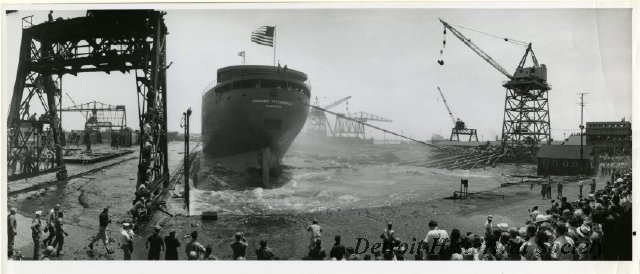The Great Lakes Engineering Works (GLEW) was a shipbuilding company headquartered in the Detroit area that made significant contributions to local history and the shipbuilding industry.
After GLEW was incorporated on June 2, 1902, it purchased the Riverside Iron Works, formerly the old Samuel F. Hodge plant at Atwater and Rivard streets, where marine engines were built. John R. Russel, Colonel F.J. Hecker, W.G. Mather, and Joseph Boyer purchased Riverside with the capitalization help of Antonio Pessano, a former Hodge plant employee. Investors contributed $1.5 million. From 1902-1905, Pessano created the largest steel shipbuilding plant on the Great Lakes. Over its 59-year history the company evolved into four locations: the Engine Works in Detroit; and three shipyards in Ecorse/River Rouge, on the St. Clair River near St. Clair, Michigan, and in Ashtabula, Ohio.
As the Detroit Riverside location could not accommodate shipbuilding, in early 1903 work began on the Ecorse shipyard. Eventually known as the River Rouge plant because of its proximity to that river, it covered 85 acres with 1,400 feet on the Detroit River. Michigan Central and Detroit Southern railroads had tracks into the yard. With four shipbuilding berths, 600 feet long, and an electric traveling crane to carry the components from shop to ships, the GLEW was a modernized shipyard. A floating dry dock was later added which could handle the largest ships.
The R.W. England, was the first steamer launched on May 5, 1904. By this time 1,600 men worked for the main engine works in Detroit, and the shipyards in Ecorse and St. Clair. The St. Clair shipyard, opened in 1904, built all of the sections for Michigan Central Railroad’s tunnel installed under the Detroit River between Detroit and Windsor. However that yard had no dry dock, and a proposal made by investors in Ashtabula, Ohio for a shipyard on the south shores of Lake Erie was accepted, closing the St. Clair yard in 1910 and opening the Ashtabula shipyard in 1911.
During World War I, the U.S. Shipping Board ordered at least 60 cargo ships from GLEW to transport ore from Lake Superior to the Midwestern blast furnaces that produced steel needed for the war effort, with ten more ordered during World War II.
The ill-fated Edmund Fitzgerald was built and launched at the River Rouge yard of the GLEW on June 7, 1958. Called the “Queen of the Lakes” because of her size at 729 feet long, the Fitzgerald couldn’t withstand the force of a Lake Superior storm on November 10, 1975 and sank, along with all 29 crew members.
The Arthur B. Homer was the last ship built by GLEW, launched on November 7, 1959, the 303rd vessel built at the River Rouge location. When Great Lakes Steel bought the company’s Detroit Riverside property in 1961 for $3.5 million, and Great Lakes Engineering Works was dissolved, many GLEW-built ships still sailed on the Great Lakes.

